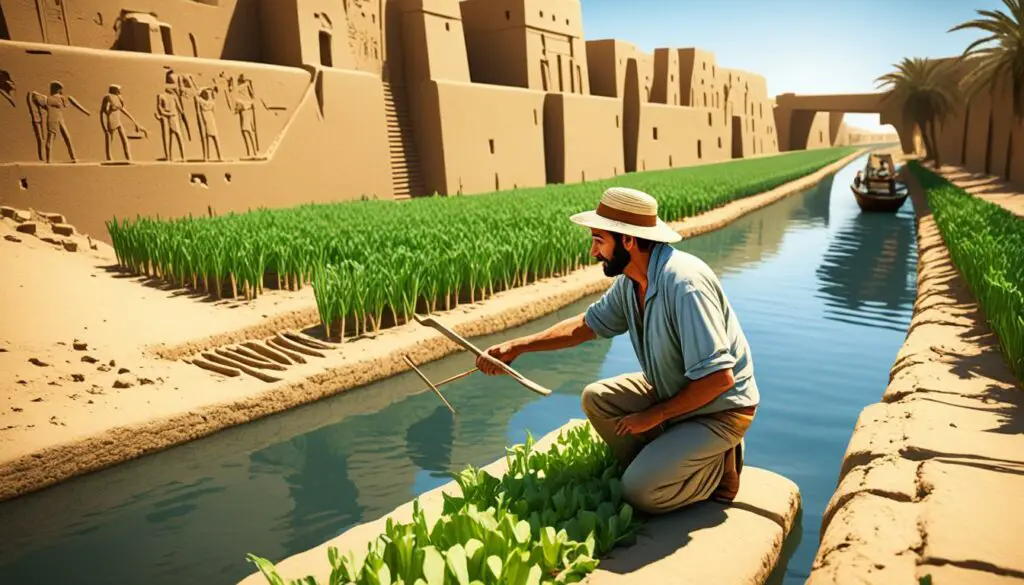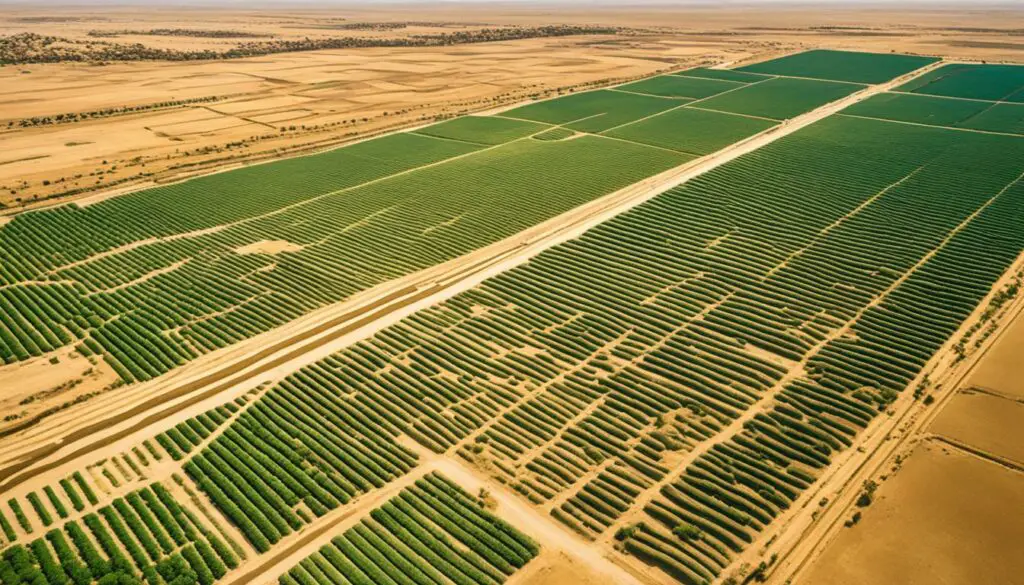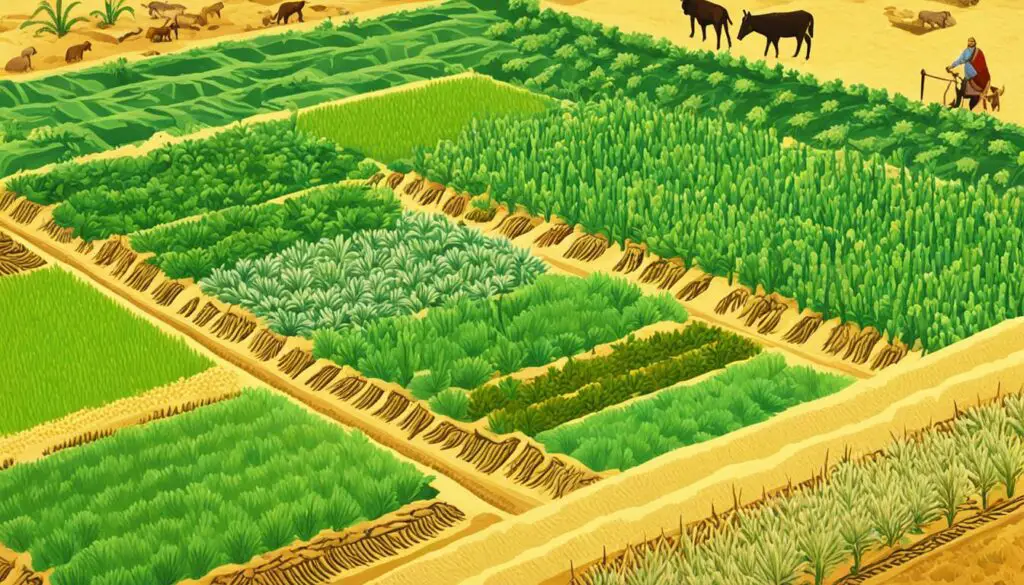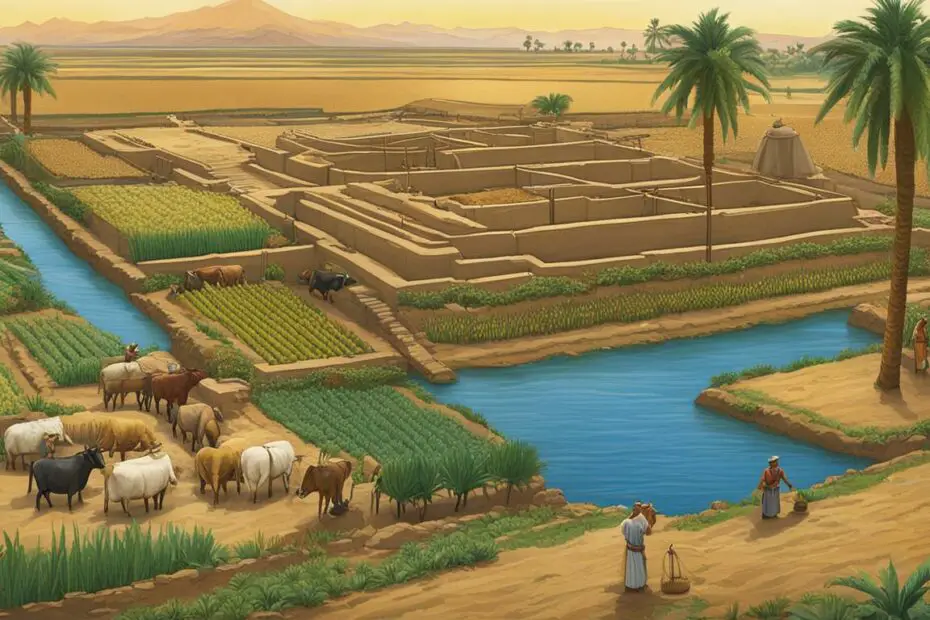Did you know that ancient Egyptians were masters of agricultural techniques that allowed them to thrive in a harsh and arid environment? From innovative irrigation systems to a diverse range of crops, their farming practices were centuries ahead of their time. So, what were the secrets to their success? Let’s dive into the world of ancient Egyptian farming and discover the techniques they used and the crops they cultivated.
The Importance of the Nile River in Ancient Egyptian Farming
The Nile River played a crucial role in ancient Egyptian farming, serving as the lifeblood of their civilization. The annual flooding of the Nile, known as inundation, was a natural phenomenon that brought numerous benefits to the farming communities along its banks.

During the inundation, the Nile River would overflow its banks, depositing nutrient-rich silt onto the surrounding land. This flooding pattern provided predictable cycles of inundation and recession, which the ancient Egyptians relied on to sustain their agricultural practices.
The fertile soil resulting from the flooding created favorable conditions for crop cultivation. The sediment carried by the river deposited a layer of nutrient-rich silt, rejuvenating the farmland and ensuring abundant harvests. The Egyptians recognized the importance of the flooding and developed their agricultural calendar around the cycles of the river.
Without the annual flooding, the land would become arid and unsuitable for farming. Conversely, if the flooding was excessive, it could lead to the destruction of crops and widespread famine. Therefore, the predictability and regularity of the Nile’s flooding were crucial for the success and survival of ancient Egyptian agriculture.
The dependence on the Nile River for the water and fertile soil it provided led to the development of sophisticated irrigation systems and farming techniques by the ancient Egyptians. These advancements enabled them to maximize agricultural output and support a thriving civilization.
Irrigation Systems and Basin Irrigation
In order to effectively utilize the waters of the Nile, the Egyptians developed sophisticated irrigation systems. One of the most important techniques employed was basin irrigation, which played a crucial role in the success of ancient Egyptian agriculture.
Basin irrigation involved the construction of a network of earthen walls in the fields, strategically placed to trap floodwaters from the Nile and create basins. This ingenious system allowed the Egyptians to control the rise and fall of the water, ensuring that the soil was fully saturated for planting.
The basins acted as reservoirs that held the floodwaters, preventing excessive drainage and evaporation. This ensured that the nutrient-rich silt provided by the Nile’s flooding was effectively utilized for crop cultivation. The water in the basins would slowly seep into the soil, providing a continuous source of moisture for the crops.
One of the advantages of basin irrigation was the ability to drain excess water to basins that needed additional water supply. This allowed for careful management of water resources, ensuring that all fields received the necessary amount of water for optimal crop growth.
Basin irrigation was a sustainable and efficient technique that maximized the agricultural productivity of the ancient Egyptians. By effectively harnessing the power of the Nile River through their irrigation systems, the Egyptians were able to cultivate a diverse range of crops and sustain their civilization.

Advantages of Basin Irrigation
- Controlled water supply, ensuring soil saturation and optimal growing conditions
- Effective utilization of floodwaters and nutrient-rich silt from the Nile
- Ability to drain excess water to other basins, managing water resources efficiently
- Increased agricultural productivity and crop yields
- Sustainable and environmentally friendly irrigation technique
Horticulture in Ancient Egypt
The ancient Egyptians were not only skilled in agricultural practices but also excelled in horticulture. In addition to their field planting, they developed and maintained gardens and orchards that played a vital role in their society.
Unlike the fields located in the floodplains of the Nile, the gardens and orchards were situated further away, requiring gardeners to manually transport water for irrigation. They carried water from wells or the Nile itself to ensure the proper hydration of their crops.
These gardens and orchards were used to grow a diverse range of crops, including various vegetables, vines, and fruit trees. As agricultural technology advanced, the cultivation of fruits became particularly important, and the Egyptians grew an extensive variety of fruits in their gardens and orchards.

Horticultural Practices in Ancient Egypt
Ancient Egyptian gardeners employed different techniques to maintain their gardens and orchards. They ensured that their plants received adequate sunlight and water, and they regularly pruned and fertilized them to promote healthy growth.
The Egyptians understood the importance of proper irrigation for their horticultural endeavors. Although they had to manually transport water, they implemented efficient methods to deliver it to their crops.
Crops Grown in Ancient Egyptian Gardens and Orchards
Ancient Egyptians cultivated a wide range of crops in their gardens and orchards. Vegetables such as lettuce, onions, and radishes were commonly grown, providing a fresh and nutritious food source for their society.
Vines, including grapes, were also cultivated, allowing the Egyptians to produce wine. Fruit trees such as figs and pomegranates were grown for both consumption and trade.
The Significance of Ancient Egyptian Horticulture
Ancient Egyptian horticulture played a crucial role in enhancing the overall agricultural production of the civilization. It diversified their crop options and provided a reliable source of food beyond the staple grains and legumes cultivated in the fields.
The development of gardens and orchards demonstrated the advanced understanding of horticultural practices and the Egyptians’ ability to adapt their agricultural techniques to different environments.
Ancient Egyptian Crop Diversity
Ancient Egyptians were skilled in cultivating a diverse range of crops to meet their nutritional needs. They relied on staple food crops such as grains, including wheat and barley, which formed the foundation of their diet. Legumes like beans, lentils, chickpeas, and fava beans provided essential protein and nutrients.
The Egyptians also cultivated various types of vegetables. Root crops like onions, garlic, and radishes were commonly grown. Salad crops like lettuce and parsley were used to enhance the flavor of meals and provide additional nutrients.
Furthermore, fruits were an integral part of their agricultural efforts. Ancient Egyptians grew a wide variety of fruits, both indigenous and introduced. Indigenous varieties included the palm date and sorghum, while introduced fruits comprised grapes, watermelon, figs, dom palm, and pomegranate.
To visualize the diversity of crops cultivated by the ancient Egyptians, refer to the table below:
| Staple Food Crops | Vegetables | Fruits |
|---|---|---|
| wheat | onions | palm date |
| barley | garlic | sorghum |
| beans | radishes | grapes |
| lentils | watermelon | |
| chickpeas | figs | |
| fava beans | dom palm | |
| lettuce | pomegranate | |
| parsley |
Ancient Egyptian agriculture thrived due to the cultivation of these diverse crops, providing a solid foundation for their society’s food security, trade, and overall prosperity.
Ancient Egyptian Agricultural Products
In addition to the cultivation of food crops, ancient Egyptians harnessed various agricultural products for a multitude of purposes. These products included papyrus, flax, henna, and a plethora of flowering and aromatic plants.
Papyrus, a highly versatile crop, served as a valuable resource for ancient Egyptians. Not only was it consumed as food, but it played a significant role in various industrial applications. Papyrus was used in the construction of boats, the creation of mats, and the development of paper, which was instrumental for recording important texts and documents.
Flax, another essential crop, was primarily cultivated for its fibers. The ancient Egyptians utilized flax for the production of rope and linen, which was the primary material for clothing. The cultivation and harvesting of flax showcased the Egyptians’ ingenuity and skill in textile production.
Henna was also an integral part of ancient Egyptian agriculture. This crop was cultivated for its dye, which was used for body adornment, decorative art, and coloring hair. The use of henna played a significant role in ancient Egyptian culture, symbolizing beauty, protection, and fertility.
Moreover, ancient Egyptians extensively cultivated over 2,000 species of flowering and aromatic plants. These plants served various purposes, including culinary uses, medicinal applications, cosmetic production, and even embalming practices. The Egyptians’ deep understanding and utilization of these plants demonstrate their advanced knowledge and expertise in agriculture.
Overall, the agricultural products of ancient Egypt, such as papyrus, flax, henna, and the diverse array of flowering and aromatic plants, played crucial roles in their society, economy, and cultural practices.

Ancient Egyptian Agricultural Techniques and Trade
The ancient Egyptians were pioneers in developing innovative agricultural techniques that greatly enhanced their farming practices. One of the key techniques they employed was the use of ox-drawn plows, which allowed them to efficiently prepare the fields for planting. These plows were instrumental in breaking up the soil and creating a suitable bed for seeds.
Another crucial agricultural technique developed by the ancient Egyptians was the use of irrigation canals. They constructed an extensive network of canals to distribute water from the Nile River to outlying farms. This irrigation system ensured that crops received a consistent water supply, promoting optimal growth and yield. The canals also played a vital role in maintaining an even saturation of crops throughout the fields.
The ingenious agricultural techniques employed by the ancient Egyptians were so effective that they influenced other ancient cultures, including Greece and Rome. The abundance of crops resulting from these techniques supported a thriving economy through trade. Ancient Egypt was a hub of agricultural trade, with agricultural goods being widely traded both within the country and with neighboring regions.
Agriculture held immense significance in ancient Egyptian society, serving as the backbone of their economy. The success of their agricultural practices and the resulting surplus of crops allowed them to establish a prosperous civilization. The ancient Egyptians’ mastery of agricultural techniques and their active participation in international trade contributed to their elevated status in the ancient world.
FAQ
Q: How did ancient Egyptians rely on the Nile River for farming?
A: The ancient Egyptians relied on the Nile River’s annual flooding, which provided fertile soil for agriculture.
Q: What farming techniques did ancient Egyptians use?
A: Ancient Egyptians used innovative farming techniques such as basin irrigation.
Q: What crops did ancient Egyptians cultivate?
A: Ancient Egyptians cultivated a variety of crops, including staple food crops like wheat and barley, as well as industrial crops like flax and papyrus.
Q: How did the Nile River contribute to ancient Egyptian farming?
A: The flooding of the Nile River deposited nutrient-rich silt on the land, creating fertile soil for crops.
Q: What was basin irrigation and how did ancient Egyptians use it?
A: Basin irrigation was an important technique in ancient Egyptian agriculture. They constructed earthen walls in their fields to trap floodwaters and create basins, allowing them to control water levels for optimal planting.
Q: Why was horticulture important in ancient Egypt?
A: Horticulture, including the development of gardens and orchards, was an important aspect of ancient Egyptian farming, offering a wide variety of crops.
Q: What types of crops did ancient Egyptians grow?
A: Ancient Egyptians grew various crops, including staple food crops like grains and legumes, as well as fruits, vegetables, and herbs.
Q: What were the agricultural products used in ancient Egypt?
A: Ancient Egyptians used agricultural products such as papyrus for boat-making and paper, flax for rope and linen, and henna for dye.
Q: What agricultural techniques did ancient Egyptians develop?
A: Ancient Egyptians used ox-drawn plows and irrigation canals to enhance their farming practices.
Q: How did ancient Egyptian agriculture support their economy?
A: The abundance of crops in ancient Egypt supported a thriving economy through domestic and international trade of agricultural goods.
